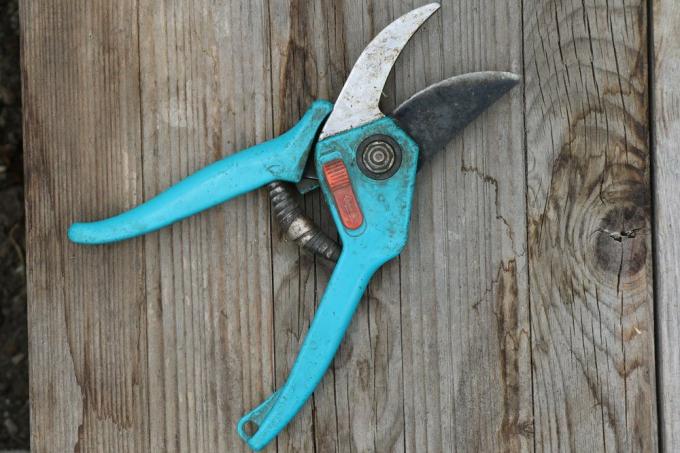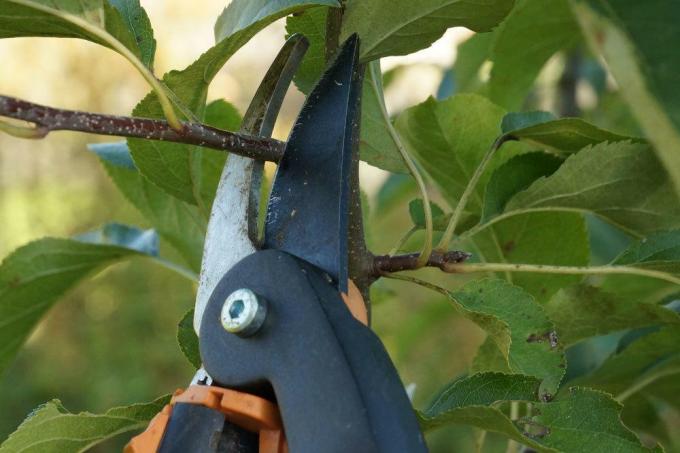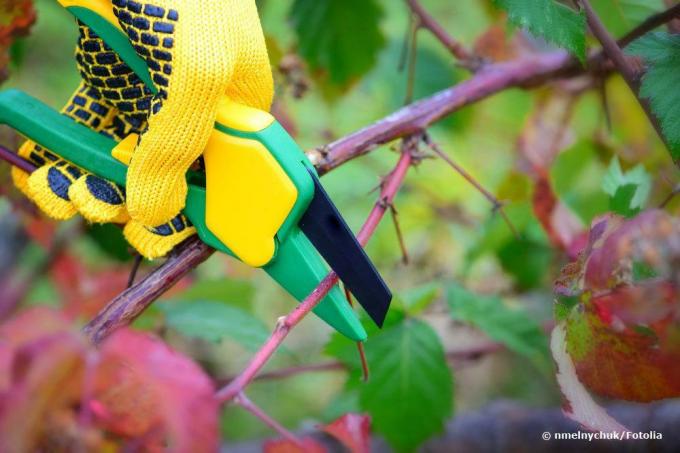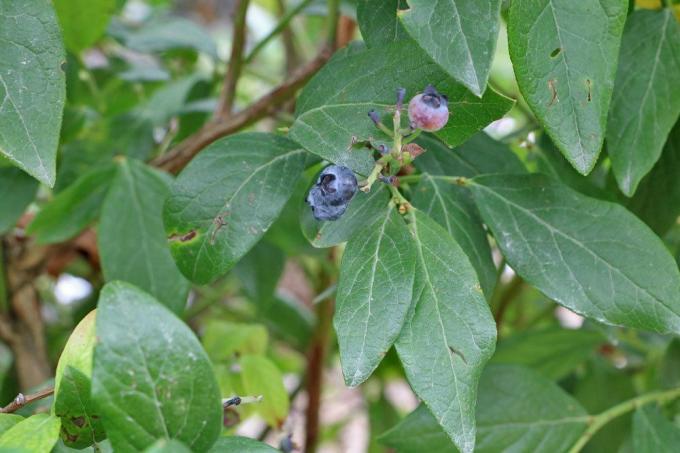
table of contents
- Berry bushes
- time
- Method & cutting
- Blackberries
- Raspberries
- Currants & Gooseberries
- blueberries
- Utils
- frequently asked Questions
So that juicy fruits grow and a lush harvest sweetens the autumn, berry bushes must be pruned regularly. The right time and the appropriate approach play an extremely important role.
In a nutshell
- Cutting is essential for a rich harvest
- Start pruning at least once a year
- Always wait for the harvest or even winter first
- Method depends on the variety of berry bushes
- Use only sharp and disinfected utensils
Berry bushes
The multi-faceted berry bushes are very popular plants in the gardens at home, the fruits of which are delicious and healthy. Consumption is possible both raw and in prepared desserts. In addition, the care of the bushes is relatively easy. However, it is extremely important to prune the plants regularly. Otherwise they grow together to form an impenetrable undergrowth, which is difficult to tame in view of the prickly varieties. In the course of time, the flowering phase becomes less and less and the fruits more and more sparse. To prevent this from happening, cut back the berry bushes. In this way, the health and vitality of the plants can be maintained for much longer. The sun can then better reach the ripening berries in the following growing season. When pruning, it is necessary to distinguish between old and young shoots.

- Currants and gooseberries are widespread
- Followed by blackberries, raspberries and blueberries
- Pruning improves the yield and quality of the harvest
- Without cutting, the bushes grow old
- The older the wood, the darker the color of the bark
- When buying, give preference to fungus-resistant and robust varieties
Tip: If you are not sure about the optical differentiation of the shoots and their age, you can equip the tendrils with different colored pendants.
time
With most berry bushes, the optimal moment for cutting occurs when all berries have fully ripe and harvested. However, there are varieties that can even be pruned twice. If you start pruning in winter, you must make sure to choose a day with frost-free and overcast weather conditions. Otherwise there is a risk that the trimmed shoots will freeze and die after cutting at minus temperatures.
- Wait for the time after the full harvest
- Then thin out in late summer or early autumn
- Carry out winter pruning from February to March
- Proceed before budding begins
- Start pruning during mild weather conditions
Method & cutting
When thinning out and pruning the berry bushes, there are some differences that need to be taken into account depending on the variety. Generally, regularly thinned bushes bear more fruit and are easier to harvest. Regarding the method used, there are some general principles that apply to all crops. However, cutting errors quickly occur, from which the plants suffer and can even react by not harvesting. Therefore a careful and correct approach is necessary.

- Thinning out increases the incidence of light for the bushes
- As a result, berries can ripen better
- This intensifies the taste of the fruit over the long term
- Eliminate rods that are too close together
- Pruning encourages the whole plant to grow
- Remove shoots that are growing too much inward
- Cut excess and weaker tendrils
Note: The fewer fruit stems that remain after cutting, the better the fruit quality and the larger the berries grow.
Blackberries
Blackberry bushes develop their sweet fruits on the annual side branches, which grow from the biennial and up to 2 meter long branches. Once a tendril has borne the delicious blackberries, it will not do it again. This is why pruning is important to make enough space for new rods that will bloom and bear fruit in the following year. The cut should only be made in early spring, as a thicket of older tendrils provides warming protection for the younger branches during the cold season. In this way, the bushes are also protected against the winter sun and do not sprout too early.

- Cut off harvested rods from the previous year
- Place the cut back at floor level
- Also cut back side shoots
- About 2 to 3 eyes remain
- Make an incision 0.5 to 1 centimeter above the eye
- Let the young and juicy green tendrils stand
- Concentrate on about 3 to 5 of the strongest new shoots
- Loosely tie the rest of the annual twigs to the trellis
Note: The cut must not be made into the bud, nor must long stumps remain.
Raspberries
In the case of raspberries, there is a basic distinction between summer-bearing and autumn-bearing varieties. In the summer-bearing varieties, the young shoots are left on the bush for the coming harvest, the rest is removed. This means that the remaining tendrils have sufficient space to develop new flower stems and additional side branches. In contrast, autumn-bearing raspberries sprout completely from the ground, so that the next harvest also forms on these new shoots.

- Start summer pruning with worn rods
- Also remove the weaker branches
- Leave about 5 to 7 strong tendrils per meter
- Cut off the entire shrub when pruning in autumn
- Perform radical cut in November
- Always proceed close to the ground when pruning
Currants & Gooseberries
The pruning of the currants is similar to that of the Gooseberries. These shrubs require a structure that extends over many years. For this reason, a parental cut must be carried out every year, in which branches that are 4 to 5 years old are to be removed. In this context, the older branches can be recognized by their darker wood color and thickness.

- Let about 3 to 4 strong new shoots stand
- Remove other ground shoots at the base
- Thinning out excess and weak new shoots
- Shorten rods that are too long and overhanging
- Also remove tendrils that grow inward
- Preserve 5 to 8 main shoots in currants
- Gooseberry bushes ideally have 8 to 12 shoots
- Leftover branches are up to 4 years old
blueberries
Blueberries are the right shrub for those who have little space in the garden. In addition, the small trees bear their delicious fruits even if they are not extensively pruned every year. Therefore, the low-growing plants are very easy to care for and frugal. However, after a few years the quality of the fruit and the yield of the harvest deteriorate. Then the time has come to expand the incision care.

- Carry out a cut for thinning in spring
- Remove the oldest scaffold shoot
- Also eliminate crossing and dead shoots
- Just like rods that are too close together
- Taper pruning is only required every 4 to 5 years
- Cut off all old shoots just above the ground
- Leave the young and green rods from the previous year
Utils
When pruning, the utensils are extremely important in order not to unnecessarily damage the trees. With the right cutting tool, precise cuts can be made in the desired places without crushing the branches. That is why it is worth investing in high-quality models. In addition, a container for the clippings should be available next to the shrub. This way, contact with the beastly branches can be minimized.
- Use only sharp and clean devices
- Disinfect extensively before use
- Sharpen cutting tools regularly
- The model depends on the size and thickness of the branches
- Anvil and bypass scissors are well suited
- Available with both short and long handles
Tip: Use well-fitting work gloves when pruning to protect your hands and forearms from the thorns of the berry bushes.
frequently asked Questions
Those who cut their berry bushes every year can not only look forward to a higher fruit yield. In addition, the shrubs grow much healthier as a result, as this avoids fungal infections.
When the summer raspberries grow on the trellis, it makes sense to shorten the tips of the young rods to trellis height in March. This process results in even larger and juicier berries.
Flowering and fruiting branches depend on a lot of light and air. Therefore, the tendrils should always be loosely arranged around the main shoot. Superfluous and cross-growing side shoots are to be removed accordingly.
If the bushes are never cut back, extremely dense undergrowth will form after a few years. Due to the spines in certain varieties, the branches get caught and are difficult to detach from each other. In addition, the trees put all their energy into developing the shoots and only bear a few berries.
